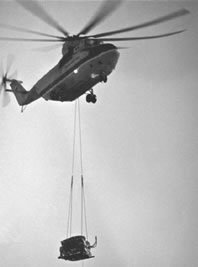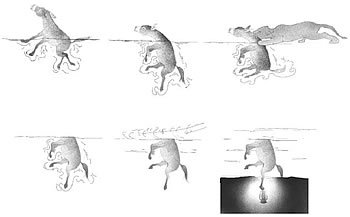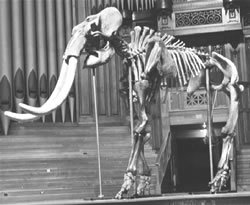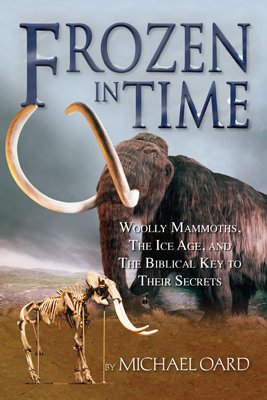
Chapter 15
Were Siberian Mammoths Quick Frozen?
Despite its appeal, there is much evidence against the quick-freeze hypothesis.
The complete disappearance of the woolly mammoths and other animals that thrived during the Ice Age is a major mystery of paleontology. Based on the carcasses and the state of preservation of the stomach food, a quick freeze appears reasonable.
Many theorists have advocated a quick freeze to account for the frozen mammoths and other animals in Siberia, as well as the lowlands of Alaska and the Yukon. The quick-freeze hypothesis is an old idea, developed by scientists in the late 19th century.1 Birds Eye Frozen Foods Company ran an experiment based on heat conduction and the state of preservation of the stomach contents. They concluded that the atmospheric temperature had to quickly fall below -150°F (-100°C).2
Evidence against the quick freeze
Despite its appeal, there is much evidence against the quick-freeze hypothesis.3 One of the more obvious evidences is that the woolly mammoths of Siberia and elsewhere are associated with the Ice Age and not the Genesis flood (see appendix 4). Most creationists who advocate a quick freeze4 believe it occurred at the onset of the Flood.
A second problem with the quick-freeze hypothesis is the very small number of carcasses compared to the number of decomposed mammoths that are entombed in the permafrost. In 1929, there were only 39 known carcasses of woolly mammoths and rhinoceroses.5 Of these, only about a half dozen were fairly complete; most of the 39 animals consisted of only a few small remnants of soft tissue attached to the bones.6 Since 1929, a few dozen new carcasses have been discovered, including the baby mammoth, Dima, found in 1977.7 Walter Brown8 lists 58 carcasses as of 2001.

Figure 15.1. A helicopter removes a block of permafrost believed to contain the Jarkov mammoth.
The Jarkov mammoth was excavated in north central Siberia in 19999 and was widely publicized as a carcass encased in a block of permafrost in two Discovery Channel documentaries in 2000 and 2001. Figure 15.1 shows a helicopter pulling out a block of permafrost believed to contain the Jarkov mammoth. Unfortunately, upon thawing out the block, they found only a skeleton with a small strip of flesh.
Advocates of the quick-freeze hypothesis estimate that probably thousands of woolly mammoth carcasses are buried in the permafrost.10 However, it is hard to determine how many carcasses still lie hidden in the permafrost. The ones that have been found represent rare finds that are usually discovered after a river has eroded its banks. Many more than Tolmachoff’s figures have been found by the native Siberians, who are reluctant to report a carcass to the authorities or scientists because of their superstitions. These have been left to rot or are eaten by wolves or Arctic foxes. On the other hand, ivory hunters have not been afraid to report a mammoth carcass and have combed Siberia for several hundred years, reporting thousands of mammoth tusks but very few carcasses. Furthermore, even if a carcass is reported, until recently it was very hard to mount an expedition to retrieve it in the barren, almost impassible terrain of Siberia. Tolmachoff11 estimated that the number of carcasses with some remaining soft parts is probably hundreds or possibly thousands of times more than was known in 1929. This would bring the possible number of carcasses up to about 50,000. This is still a small number, compared to the many millions that have been entombed in the permafrost. Thus, even if Tolmachoff’s estimate is correct, the number of carcasses is still rare.
The scarcity of mammoth carcasses indicates that most died a normal death and decayed. Therefore, it is reasonable to conclude that nearly all of the mammoths and other animals died and decayed normally before, or while becoming interred in the permafrost.12 This suggests that the rare intact carcasses are the result of unique circumstances.
Third, the carcasses often show evidence of partial decay.13 The meat is not fresh as some people have asserted. For instance, the internal organs of the Beresovka mammoth had rotted away and the stomach was badly decayed when it was found.14 The Shandrin carcass found in 1972 was composed of a complete mammoth skeleton with some preserved internal organs and over 600 pounds (275 kg) of plant matter from the gastrointestinal tract.15 The remainder of this mammoth had decomposed. Some of the abdominal parts of the Selerikan horse, found on the upper Indigirka River in 1977, were quite decayed by enzyme action.16 Much of the muscle tissue of the Yuribei mammoth, found in 1979, on the Yuribei River near the Arctic coast of northwest Siberia, was decomposed.17 If they had been quick frozen and rapidly buried, there should have been much less decay.
Fourth, fly pupae are often found associated with bones and carcasses.18 This is a sign of an unsensational death and decay. Guthrie19 states that fly pupae are common in Alaskan Ice Age bones; some have been found wedged into the brain case. More than 1,000 blowfly pupae cases were found within the nasal cavity of one of the mammoth partial carcasses found at Colorado Creek, Alaska, in 1983.20 It is unlikely these fly pupae were laid after modern exposure. Fly pupae should not be associated with bones and carcasses if death and burial were by a quick freeze.
Fifth, signs of scavenging are occasionally found on the newly retrieved carcasses. Guthrie21 has discovered numerous signs of the scavenging of Blue Babe, the partial bison carcass found in the muck near Fairbanks, Alaska. The signs included bite and claw marks, probably from lions; pieces of bone and flesh scattered about the carcass; and a large tooth fragment embedded in the neck. Evidence of scavenging was also discovered on two partial mammoth carcasses from Alaska.22 The Selerikan horse had no head, suggesting scavenging after death. Since the horse was in a general standing position with its hind legs lower than its front legs, Guthrie23 speculates the horse sank up to its neck in a bog and a carnivore ate its head (figure 15.2). The last frame in figure 15.2 shows how the horse was discovered by gold miners, who used the horse’s hooves hanging from the ceiling to hold their lantern. The idea of a carnivore eating its head while stuck up to its neck is a reasonable conclusion. However, the surrounding sediments are not bog sediments, and besides, why didn’t the predator also sink in the bog? An alternate possibility will be provided in the next chapter. How could the quick freeze hypothesis explain such scavenged carcasses?

Figure 15.2. This series of illustrations demonstrates how Guthrie believes the Selerikan horse died and lost its head. Note that the carcass is in a general standing position.24
Sixth, the animals preserved as carcasses appear to have died at different times of the year.25 A quick freeze would be instant and in the same season. Indications as to the time of death include the type and seasonal development of its stomach vegetation, the condition of its pelt, the presence of insects, and the characteristics of the teeth and tusks. The famous Beresovka mammoth is believed to have died in late summer or early fall. Although somewhat controversial, numerous Alaskan mammoth teeth indicate most deaths happened during the winter.26 But the abundant fly pupae associated with one of the Colorado Creek, Alaska, mammoths, along with dung beetles in the mammoth dung from the site (dung beetles are only attracted to fresh dung), points to a summer death for this mammoth.27
Table 15.1: Estimated seasons of death for various frozen carcasses
1) Beresovka mammoth — late summer or early autumn
2) Colorado Creek mammoth — summer
3) Selerikan horse — summer or autumn
4) Mylakhchin bison — early summer
5) Yuribei mammoth — early spring or late autumn
6) Blue Babe bison — autumn or early winter
7) Alaskan deaths — mostly winter
8) Shandrin mammoth — early spring
The Selerikan horse died when herbaceous plants were in blossom, in late July or early August.28 However, Guthrie29 thinks the horse died in late fall, based on its full winter coat and mature seeds found in its stomach. These differing opinions demonstrate the uncertain nature of some of this evidence or possibly the special environmental conditions of the area that are not according to uniformitarian expectations. The Mylakhchin bison, found in 1971, in the middle Indigirka River valley, probably died in early summer, deduced from the low amount of grass and herb fruits found in its gastrointestinal tract.30 Ukraintseva31 thinks the Yuribei mammoth died in early spring or late autumn when vegetation and flowering was not occurring. She also believes the evidence points to an early spring death for the Shandrin mammoth.32 Based on its hair and fat, Guthrie33 concludes the bison carcass named Blue Babe died sometime during the autumn or early winter. A sectioned tooth from Blue Babe showed its summer growth was complete and that the winter annulus had not yet fully developed. Although Blue Babe had numerous signs of scavenging, there were no fly pupae or scavenging beetles, confirming it died in a cooler time of year.34 Table 15.1 lists the probable seasons of death for many Ice Age mammals. Although some of these conclusions are controversial, the bulk of evidence indicates different seasons of death for the carcasses, contrary to what would be expected in an instantaneous quick freeze.
A seventh piece of evidence against a quick freeze is most of the remains in Siberia are mammoths.35 Many other types of animals that were fleeter of foot lived with the woolly mammoth, yet, many of these animals managed to escape. The most likely explanation is they migrated out of the area as the climate changed. This would have taken some time. A sudden drop in the temperature to below -150°F (-100°C) would freeze all the animals in their tracks. There should be a large number of other animals buried with the mammoths, if the quick freeze really happened. These seven pieces of evidence against a quick freeze are summarized in table 15.2. Taken together they add up to a strong case against the quick-freeze hypothesis.36
How are the stomach contents explained?
If all the above evidence suggests the mammoths were not quick frozen, then how can we explain the state of their gastrointestinal contents, the main evidence for a quick freeze?
Birds Eye Frozen Foods Company made their calculations based solely on heat conduction. Back in 1990, I suggested we examine other variables that may account for the state of preservation of the stomach contents.37 The only evidence that another mechanism could have been involved was the discovery of preserved wood fragments from the stomach of a mastodon excavated in the warm country of Venezuela.38 I should have followed up on my research at the time, since the likely solution to the question of the half-digested food in the stomach of a few woolly mammoth carcasses was already available.
Table 15.2: Summary of the evidence against a quick freeze
1) Mammals associated with the Ice Age
2) Carcasses rare
3) Carcasses partially decayed
4) Fly pupae associated with bones and carcasses
5) Signs of scavenging
6) Different seasons of death
7) Remains mostly woolly mammoths
The key, I believe, lies in the digestive physiology of the elephant, which can be used as an analog for the mammoth. Until the 1970s, little was known about their digestive system, and virtually nothing about the microbial aspects of digestion.39 This situation soon changed during elephant-culling operations in Kruger National Park in South Africa. Based on 50 freshly killed elephants, it was discovered that the main digestive process of elephants occurs after the food passes through the stomach, primarily in the cecum and colon.40 Digestion is caused mainly by bacteria and protozoa, which each newborn elephant must ingest from the outside environment to start the process. The researchers found no protozoa and no fermentation in the stomachs of the culled elephants. Furthermore, very little hydrolysis of the cellulose was taking place in the stomach, although it had a very acidic pH of about 2. This high acidity is expected to partially degrade the stomach contents. Therefore, they found the stomach is mainly a storage area before digestion.41 Gary Haynes42 explains:
The digestive system is based on postgastric (hindgut) fermentation.43 The stomach is large, but serves mainly to store ingested food. Enzymes within the stomach partly break down vegetation, but most nutrients are extracted in the huge cecum and large intestine, where microbes ferment the food remaining after gastric processing.44
Horses and rhinoceroses, but not bison, are also hindgut fermenters. The bison is a ruminant. It is interesting that the plant remains in the Selerikan horse carcass were also partly decayed,45 while the stomach contents of the Mylakhchin bison carcass were digested with the plant macro remains difficult to identify.46 This difference is what would be expected based on the different digestive processes of these animals.
Partially preserved stomach vegetation in the American mastodon

Figure 15.3. Mastodon skeleton.
Further evidence that a quick freeze is not needed to partially preserve stomach vegetation in animals with hindgut digestion comes from the American mastodon (figure 15.3). Ice Age mastodon fossils are relatively common in the northeast United States. They are sometimes found in old bogs that are mainly composed of peat. Preserved vegetation from the gastrointestinal tracks of mastodons has been reported occasionally from these bogged mastodons in the northeast United States.47 Recently the skeleton of a mastodon was discovered in peat on top of an Ice Age end moraine in Ohio.48 The remains yielded a discrete, cylindrical mass of plant material found in association with the intact vertebrae and ribs. The gastrointestinal contents had a pungent odor with a floral content markedly different from the peat. Most of the macro remains could not be identified. However, seeds in the material indicated an early autumn death, which was reinforced by an analysis of the tusk dentin. Pollen analysis indicated 62 percent herbaceous types (i.e., grazing vegetation), which is interesting since the mastodon is thought to be predominantly a browser that eats leaves and small shoots from trees and bushes.
The discoveries of plant material associated with mastodons indicate that given the right conditions (in permafrost for Siberian mammoths and peat for mastodons), the stomach contents can be preserved in various states of decay. A quick freeze is an unnecessary hypothesis.
Frozen in Time
Author Michael Oard gives plausible explanations of the seemingly unsolvable mysteries about the Ice Age and the woolly mammoths.
Read Online Buy BookFootnotes
- Digby, B., The mammoth and mammoth-hunting in north-east Siberia, H.F. & G. Witherby, London, pp. 51–55, 1926.
- Dillow, J.C., The waters above: Earth’s pre-Flood vapor canopy, Moody Press, Chicago, IL, pp. 383–396, 1981.
- Oard, M.J., The Extinction of the Woolly Mammoth: Was It a Quick Freeze? TJ 14(3):24–34, 2000.
- Dillow, Waters Above. Brown, W., In the beginning: Compelling evidence for creation and the flood, 7th edition, Center for Scientific Creation, Phoenix, AZ, 2001.
- Tolmachoff, I.P., The carcasses of the mammoth and rhinoceros found in the frozen ground of Siberia, Transactions of the American Philosophical Society 23:20, 1929.
- Ibid., p. 41.
- Stewart, J.M., Frozen mammoths from Siberia bring the ice ages to vivid life, Smithsonian 8:60–69, 1977. Stewart, J.M., A baby that died 40,000 years ago reveals a story, Smithsonian 10:125–126, 1979. Dubrovo et al., 1982 Guthrie, R.D., Frozen fauna of the mammoth steppe — The story of Blue Babe, University of Chicago Press, Chicago, IL, 1990. Ukraintseva, V.V., Vegetation cover and environment of the “Mammoth Epoch” in Siberia, Mammoth Site of Hot Springs, South Dakota, Inc., Hot Springs, SD, 1993.
- Brown, W., In the beginning: Compelling evidence for creation and the flood, 7th edition, Center for Scientific Creation, Phoenix, AZ, pp. 160–161, 2001.
- Stone, R., Siberian mammoth find raises hopes, questions, Science 286:876–877, 1999.
- Dillow, Waters Above, pp. 328–334.
- Tolmachoff, Carcasses of the mammtoh and rhinoceros, p. 41.
- Sutcliffe, A.J., On the tracks of Ice Age mammals, Harvard University Press, Cambridge, MA, p. 113, 1985.
- Sutcliffe, Tracks of Ice Age mammals, p. 113.
- Lister, A., and P. Bahn, Mammoths, Macmillan, New York, p. 44, 1994.
- Ukraintseva, V.V., Vegetation cover and environment of the “Mammoth Epoch” in Siberia, Mammoth Site of Hot Springs, South Dakota, Inc., Hot Springs, SD, pp. 67–80, 1993.
- Guthrie, Frozen fauna, p. 30.
- Ukraintseva, Vegetation cover and environment, pp. 108, 134.
- Péwé, T.L., and D.M. Hopkins, Mammal remains of pre-Wisconsin age in Alaska; in: The Bering land bridge, D.M. Hopkins (ed.), Stanford University Press, Stanford, CA, pp. 268–269, 1967. Sutcliffe, Tracks of Ice Age mammals. Thorson, R.M., and R.D. Guthrie, Stratigraphy of the Colorado Creek mammoth locality, Alaska, Quaternary Research 37:221, 1992.
- Guthrie, Frozen fauna, p. 86.
- Elias, S.A., Late Wisconsin insects and plant macrofossils associated with the Colorado Creek mammoth, southwestern Alaska: Taphonomic and paleoenvironmental implications; in: International Workshop on Classification of Circumpolar Arctic Vegetation, Institute of Arctic and Alpine Research, University of Colorado, Boulder, CO, pp. 45–47, 1992.
- Guthrie, Frozen fauna.
- Thorson, R.M., and R.D. Guthrie, Stratigraphy of the Colorado Creek mammoth locality, Alaska, Quaternary Research 37:214–228, 1992.
- Guthrie, Frozen fauna, p. 32.
- Guthrie, Frozen fauna.
- Guthrie, Frozen fauna, pp. 1–44. Ukraintseva, Vegetation cover and environment.
- Guthrie, Frozen fauna, p. 247.
- Elias, Late Wisconsin insects, p. 47.
- Ukraintseva, Vegetation cover and environment, p. 86.
- Guthrie, Frozen fauna, p. 31.
- Ukraintseva, Vegetation cover and environment, pp. 98–108.
- Ibid., p. 115.
- Ibid., p. 74.
- Guthrie, Frozen fauna, pp. 81–82.
- Ibid., pp. 84, 86.
- Ukraintseva, Vegetation cover and environment, p. 24.
- Oard, M.J., The Extinction of the Woolly Mammoth: Was It a Quick Freeze? TJ 14(3):24–34, 2000.
- Oard, M.J., An ice age caused by the Genesis flood, Institute for Creation Research, El Cajon, CA, p. 131, 1990.
- Sutcliffe, Tracks of Ice Age mammals, p. 37.
- van Hoven, W., R.A. Prins, and A. Lankhorst, Fermentative digestion in the African elephant, South African Journal of Wildlife Research 11(3):78–86, 1981.
- van Hoven, Prins, and Lankhorst, Fermentative digestion. van Hoven, W., and E.A. Boomker, Digestion; in: Bioenergetics of wild herbivores, R.J. Hudson and R.G. White (eds.), CRC Press, Boca Raton, FL, pp. 103–120, 1985.
- Eltringham, S.K., Elephants, Blandford Press, Dorset, England, p. 17, 1982.
- Haynes, G., Mammoths, mastodonts, and elephants, Cambridge University Press, Cambridge, NY, p. 58, 1991.
- van Hoven, Prins, and Lankhorst, Fermentative digestion. van Hoven and Boomker, Digestion.
- van Hoven, Prins, and Lankhorst, Fermentative digestion.
- Ukraintseva, Vegetation cover and environment, p. 83.
- Ibid., p. 100.
- Howorth, H.H., The Mammoth and the flood — An attempt to confront the theory of uniformity with the facts of recent geology, Sampson Low, Marston, Searle, & Rivington, London, pp. 289–303, 1887. Reproduced by The Sourcebook Project, Glen Arm, Maryland. Hapgood, C.H., Earth’s shifting crust — A key to some basic problems of earth science, Pantheon Books, New York, pp. 257–265, 1958. Lepper, B.T., T.A. Frolking, D.C. Fisher, G. Goldstein, J.E. Sanger, D.A. Wymer, J.G. Ogden III, and P.E. Hooge, Intestinal contents of a Late Pleistocene mastodont from midcontinental North America, Quaternary Research 36:120, 1991.
- Lepper, B.T., T.A. Frolking, D.C. Fisher, G. Goldstein, J.E. Sanger, D.A. Wymer, J.G. Ogden III, and P.E. Hooge, Intestinal contents of a Late Pleistocene mastodont from midcontinental North America, Quaternary Research 36:120–125, 1991.

Answers in Genesis is an apologetics ministry, dedicated to helping Christians defend their faith and proclaim the good news of Jesus Christ.
- Customer Service 800.778.3390
- Available Monday–Friday | 9 AM–5 PM ET
- © 2026 Answers in Genesis

